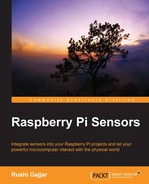With some knowledge on OpenCV, you can go ahead and read the manuals of OpenCV to gain more knowledge on how functions and arguments are passed. Initially, it can be somewhat difficult for you to start OpenCV using image pointers. There is an immense amount of help available at http://www.opencv.org. While taking help from the Internet and the code available from the official website, check for the OpenCV language (platform) first. It has been observed that when C code merges with C++ code, it doesn't work even after banging your head for hours. It is advised to keep The OpenCV Reference Manual (Current Release 2.4.9.0) with you while coding OpenCV.
It would be quite a good challenge for you to develop a project that fulfils the following requirements:
- Capture live images using the interfaced camera, split the image into segments of the same size (say, four vertical segments), and compare it with the reference image. There will be a clear difference in one of the segments where most of the motion is observed. Detect that area in the image and trigger the GPIO accordingly.
- Further, control a servomotor or stepper motor to rotate the camera according to the movement in front of it. Finally, you will be able to develop a camera that follows you wherever you move.
- Another application of this is to save energy. Split the image into coordinative segments and detect where people are sitting in the room by setting the camera at the heighted position. Turn off the light where zero motion is detected. Interesting, isn't it?
- You can develop OpenCV code to track a particular colored object. The code can draw the lines on the screen while this colored object is moved in front of a camera. For example, when we show and move a red ball in front of the camera lens, it starts drawing lines as per the red color's movements detected by camera.
- Create a gesture/pattern-recognizable computer module that takes commands as per the color rings worn on your fingers.
- Build a ball-following robot that can follow a ball of a particular color and detect the near and far effects of the ball.
After building these projects, you can show them to your friends and be the coolest person among them. It can be really very interesting to build these projects, can't it? Then build it!
